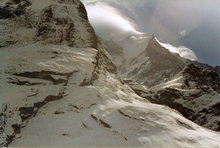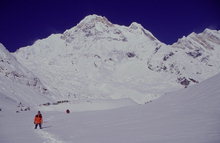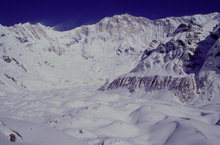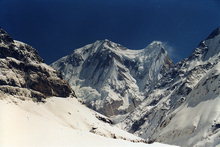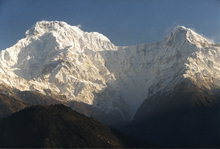
Annapurna Sanctuary
Annapurna Sanctuary is a fascinating patch of land in the heart of the
Himalayas. About a dozen high peaks form roughly a circle with 10km
diameter. Most of the mountains are in the 6000-8000m range, with the
magnificent Annapurna I being the highest at 8091m. The bottom of this
large bowl lies at 4200m. The walls of this circle create a formidable
barrier; they never descend below 5500m, except for one narrow valley
which allows reasonably easy access into the Sanctuary... that is if there
are no avalanches.
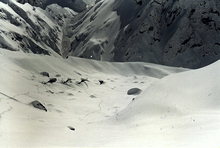 My trek to Annapurna Sanctuary was made much more interesting by the
exceptionally bad weather. They say in March there is usually no snow
in the Sanctuary. Even the ACAP checkpoint people in Birethanti assured me
that everything was fine. I wasn't more than half an hour out of Birethanti
when I met the first disappointed trekker coming back. He said there
were avalanches all over the place, and claimed it was impossible to go
to Sanctuary.
My trek to Annapurna Sanctuary was made much more interesting by the
exceptionally bad weather. They say in March there is usually no snow
in the Sanctuary. Even the ACAP checkpoint people in Birethanti assured me
that everything was fine. I wasn't more than half an hour out of Birethanti
when I met the first disappointed trekker coming back. He said there
were avalanches all over the place, and claimed it was impossible to go
to Sanctuary.
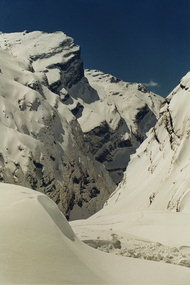 Later it turned out that it had been snowing for quite some time, there were
6 feet of snow in the Sanctuary, and the avalanche danger was extremely real
(5+ avalanches a day). However, "impossible" was a too strong word, and it is
incredible how variable are trekkers expectations and personal limits in
terms of trail conditions etc. Many trekkers regarded everything that
didn't involve a clear trail as "impossible"; one of them asked me point
blank "how could you go forward if there is no trail?". At the same time,
there were others who could happily spend a cold day making the journey
down from the Sanctuary in heavy rain/snow/hail, all the time hip deep in
the snow! Needless to say they had nothing resembling a trail.
To everyone heading to Annapurna Sanctuary, go for it, even if there is
lots of snow; it can probably be boring if there isn't any.
Later it turned out that it had been snowing for quite some time, there were
6 feet of snow in the Sanctuary, and the avalanche danger was extremely real
(5+ avalanches a day). However, "impossible" was a too strong word, and it is
incredible how variable are trekkers expectations and personal limits in
terms of trail conditions etc. Many trekkers regarded everything that
didn't involve a clear trail as "impossible"; one of them asked me point
blank "how could you go forward if there is no trail?". At the same time,
there were others who could happily spend a cold day making the journey
down from the Sanctuary in heavy rain/snow/hail, all the time hip deep in
the snow! Needless to say they had nothing resembling a trail.
To everyone heading to Annapurna Sanctuary, go for it, even if there is
lots of snow; it can probably be boring if there isn't any.
When approaching the Sanctuary, you usually start out from the nearest
road (at Birethanti or Naudanda Phedi). You will cross three different
areas: the hills (Birethanti-Chhomrong), the valley leading into the
Sanctuary (Chhomrong-MBC), and then the Sanctuary itself (MBC-ABC).
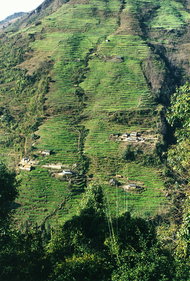
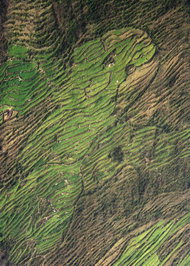
The hills
In Nepal, something is called a "mountain" only if it's about 5500m or
higher. Anything less than that is a hill. This means that the mountains
actually take up a rather small area of Himalayas; indeed the white part
of Annapurna massif is only about 25km wide. This is surrounded by a much
wider green belt of hills. The hills are relatively well populated. Most of
the 45-degree hillslopes are cultivated, in order to feed all these mouths.
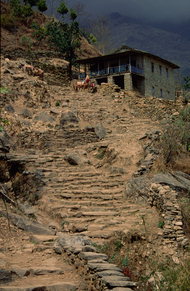 There are good trekking trails in the hills, and the only trekking advice
I can give is that the trail that is advocated by ACAP people et al
(Birethanti-Ghandruk-Chhomrong-...) is not the quickest/easiest way.
The easiest is Birethanti-Jhinu Danda-Chhomrong-... For the first hour from
Birethanti, it follows the same popular Birethanti-Ghandruk trail, but then
at Syauli Bazaar, just when the trail starts the steep 900-metre climb to
Ghadruk, the Jhinu Danda trail turns right and avoids the climb. The climb
is pointless, because after Ghandruk the trail goes back down anyway. So it's
nicer to avoid it, and continue on along the Modi Khola river up until Jhinu.
This trail sees less people, is more interesting, and will save you half a day.
There are good trekking trails in the hills, and the only trekking advice
I can give is that the trail that is advocated by ACAP people et al
(Birethanti-Ghandruk-Chhomrong-...) is not the quickest/easiest way.
The easiest is Birethanti-Jhinu Danda-Chhomrong-... For the first hour from
Birethanti, it follows the same popular Birethanti-Ghandruk trail, but then
at Syauli Bazaar, just when the trail starts the steep 900-metre climb to
Ghadruk, the Jhinu Danda trail turns right and avoids the climb. The climb
is pointless, because after Ghandruk the trail goes back down anyway. So it's
nicer to avoid it, and continue on along the Modi Khola river up until Jhinu.
This trail sees less people, is more interesting, and will save you half a day.
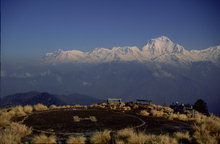 Due to the bad weather in the Sanctuary, I decided to look around the hills
a little more, and return to Sanctuary area later for a second try.
One of the trekkers attractions around here is Poon Hill (3200m). They say
you can see about 50 mountains (see definition of a mountain above)
from Poon Hill. However it is 20-30km away from these mountains, and
therefore it doesn't really appeal to those who like mountains up close,
such as yours truly. But I don't regret going to Poon Hill, it was nice
to sit there on the hilltop and admiring the morning light on Dhaulagiri
and all the others. It just wasn't a major thing for me.
Due to the bad weather in the Sanctuary, I decided to look around the hills
a little more, and return to Sanctuary area later for a second try.
One of the trekkers attractions around here is Poon Hill (3200m). They say
you can see about 50 mountains (see definition of a mountain above)
from Poon Hill. However it is 20-30km away from these mountains, and
therefore it doesn't really appeal to those who like mountains up close,
such as yours truly. But I don't regret going to Poon Hill, it was nice
to sit there on the hilltop and admiring the morning light on Dhaulagiri
and all the others. It just wasn't a major thing for me.
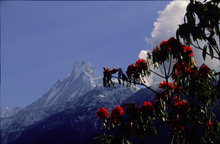 People are cheerful in Nepal. When I was just finishing going around and
around in the hills, it just happened that it was the time for Holi festival.
One of the legends relevant to Holi is about Krishna -- a name that should
be well known to anyone inquiring about the Subcontinent. Sometimes Krishna
gets into all sorts of mischief, often involving stealing clothes from
young ladies going skinny dipping in secluded lakes. All that while staying
faithful to his wife, of course. So rest assured, this is what Holi is all
about. No, lakes and young ladies are not on the menu, but Nepalis make up
for it by pouring red powder paint on everyone and everything. True enough,
the day before Holi I saw a completely red old man already.
People are cheerful in Nepal. When I was just finishing going around and
around in the hills, it just happened that it was the time for Holi festival.
One of the legends relevant to Holi is about Krishna -- a name that should
be well known to anyone inquiring about the Subcontinent. Sometimes Krishna
gets into all sorts of mischief, often involving stealing clothes from
young ladies going skinny dipping in secluded lakes. All that while staying
faithful to his wife, of course. So rest assured, this is what Holi is all
about. No, lakes and young ladies are not on the menu, but Nepalis make up
for it by pouring red powder paint on everyone and everything. True enough,
the day before Holi I saw a completely red old man already.
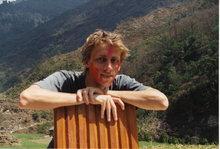 The next day I was going
from Birethanti to Jhinu, and Nepali artists added more and more to the
decaration of my face along the way. This was apparently not the usual style,
and seeing me cheered up everyone I met. The comments ranged from
Beautiful! (women) to Like a monkey (men). The most cheerful
people live in Jhinu Danda. All they seem to do is sit outside in small
groups and laugh at each others jokes. At some point in time, two Nepali
musicians appeared; to the utter enjoyment of the locals, they started
singing apparently very funny songs. I have no idea what the songs were
about -- maybe about a weird foreigner with a face red and green.
Too bad I don't speak any Nepali.
The next day I was going
from Birethanti to Jhinu, and Nepali artists added more and more to the
decaration of my face along the way. This was apparently not the usual style,
and seeing me cheered up everyone I met. The comments ranged from
Beautiful! (women) to Like a monkey (men). The most cheerful
people live in Jhinu Danda. All they seem to do is sit outside in small
groups and laugh at each others jokes. At some point in time, two Nepali
musicians appeared; to the utter enjoyment of the locals, they started
singing apparently very funny songs. I have no idea what the songs were
about -- maybe about a weird foreigner with a face red and green.
Too bad I don't speak any Nepali.
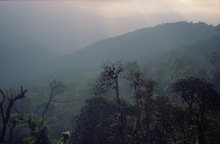
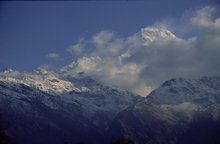 Curiously enough, I met an American who did. His father had worked as an
engineer near Pokhara, and so he spent the first 14 years in his life in
Nepal. Only when he was 14 did this American actually see America. I asked
him which country he liked better -- he laughed and said no question about
it, Nepal! Now he was in Nepal again, showing around the country to his
college friends.
Curiously enough, I met an American who did. His father had worked as an
engineer near Pokhara, and so he spent the first 14 years in his life in
Nepal. Only when he was 14 did this American actually see America. I asked
him which country he liked better -- he laughed and said no question about
it, Nepal! Now he was in Nepal again, showing around the country to his
college friends.
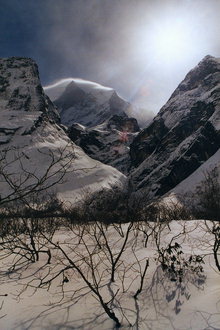
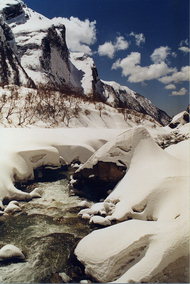
The valley
Upper Modi Khola valley is the next level on your way to the Sanctuary.
It's a very narrow place confined between two high mountains: Machhapuchare
(6995m) and Hiunchuli (6441m). You can see them both on pictures above:
Hiunchuli is the "small bump" on the right side of the very first
photo, and Machhapuchare is the one with the blooming rhododendron.
From the valley itself, you can not really see either of these mountains --
the slopes are too steep.
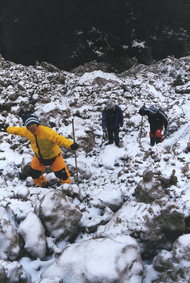
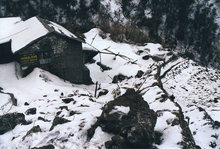 However, with inclement weather, you are constantly reminded of their
existence by the avalanches, which are especially likely to come from Hiunchuli.
Sometimes their rumble wakes you up at night; at other times, you mistake
them for thunder, or just get used to them to the point of not noticing.
In the morning, you sometimes find a fresh one 500m from your lodge (like I did).
Sometimes you have to run away from one (like some Kiwi girls did).
To the right you can see some trekkers climbing up an avalanche track;
to the right there are Himalaya Hotel houses which almost got hit by an
avalanche which was 800 meters wide.
However, with inclement weather, you are constantly reminded of their
existence by the avalanches, which are especially likely to come from Hiunchuli.
Sometimes their rumble wakes you up at night; at other times, you mistake
them for thunder, or just get used to them to the point of not noticing.
In the morning, you sometimes find a fresh one 500m from your lodge (like I did).
Sometimes you have to run away from one (like some Kiwi girls did).
To the right you can see some trekkers climbing up an avalanche track;
to the right there are Himalaya Hotel houses which almost got hit by an
avalanche which was 800 meters wide.
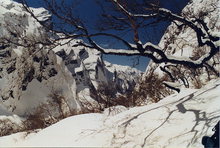 Avalanches are less likely to occur in the morning, and that's why we started
at 6am from Doban (2500m). We went to Annapurna South base camp (4150m) in
one day. It had been more than ten years
since I had been above 3500m, and it was the most amazing day you could imagine.
In the end, the valley gets wider, and it looked wonderful. When the snow
started at about 3000m, I had to wear sunglasses, and everything seemed more
and more bizarre through them. The sun, a small rainbow on the side of
Machhapuchare, "smoking" mountaintops, heat, cold, wind, lack of oxygen.
Avalanches are less likely to occur in the morning, and that's why we started
at 6am from Doban (2500m). We went to Annapurna South base camp (4150m) in
one day. It had been more than ten years
since I had been above 3500m, and it was the most amazing day you could imagine.
In the end, the valley gets wider, and it looked wonderful. When the snow
started at about 3000m, I had to wear sunglasses, and everything seemed more
and more bizarre through them. The sun, a small rainbow on the side of
Machhapuchare, "smoking" mountaintops, heat, cold, wind, lack of oxygen.
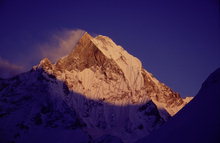
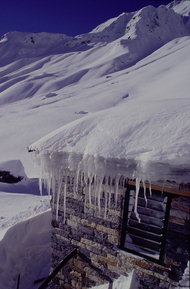
The Sanctuary itself
The avalanche dangers ended when we entered the Sanctuary proper. 6 feet
of snow as we were told. In the base camp, the night attire was as follows:
warm underwear, two pairs of socks, two T-shirts, and a sweater.
On top of the sleeping bag I had my jacket too. It was still cold.
I had planned just to go to Sanctuary, spend a night there, and come back
in the morning. The weather had other plans, however. We woke up in the
morning, only to see a curtain of fog and falling snow. So much for the
much-glorified Annapurna sunrise! Visibility was 50m for most of the day.
At noon, it all escalated into a real snowstorm. Everyone gathered
to the dining room to play cards, read, and chat. The dining room was
freezing, but so were our own rooms. During the gusts, the snow was
falling in the dining room as well.
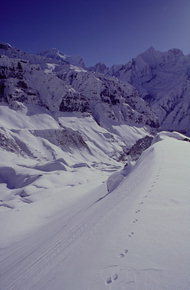
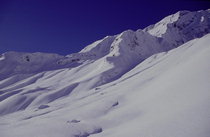 All trekkers in the base camp had thus just one single problem: how to
get down from the base camp? The next possible place of for lodging is
Machhapuchare base camp (MBC), which is 3000m away horizontally, and 500m
lower vertically. It takes 2-3 hours to cover that distance in deep snow,
and with 50m visibility the chances of getting lost are not slim at all.
Some of us made some attempts to go down. Most of them turned back within
15 minutes. Since I had time, and still remembered my similar experiences
in Kuznetski Alatau, I didn't feel like
giving it a try.
All trekkers in the base camp had thus just one single problem: how to
get down from the base camp? The next possible place of for lodging is
Machhapuchare base camp (MBC), which is 3000m away horizontally, and 500m
lower vertically. It takes 2-3 hours to cover that distance in deep snow,
and with 50m visibility the chances of getting lost are not slim at all.
Some of us made some attempts to go down. Most of them turned back within
15 minutes. Since I had time, and still remembered my similar experiences
in Kuznetski Alatau, I didn't feel like
giving it a try.
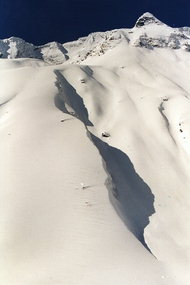
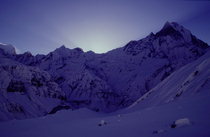 Suddenly someone noticed new trekkers coming up from MBC through the storm!
They were about 700m away. Boredom makes people do weird things, and thus
we set up a bet where we tried to predict their arrival time.
Everyone paid 10 rupees, and in the end it was all going to belong to the
winner! I predicted 65 minutes. The local lodgeowner said naah, 80 minutes.
We observed our subjects through binoculars; they were obviously having
a hard time in that snow and altitude, but we had a lot of fun at their expense.
Some of us (who predicted too short a time) wanted to run out and help them.
Some others were more inclined to run out and yell "NO! Don't come here, the
trail is that way!" or "AVALANCHE!!!". This last line was everyone's
favourite. Anyway, finally they arrived. They were Japanese. As the first
of them stumbled into the lodge, he mumbled something... Paddy translated:
I'm dying.
Suddenly someone noticed new trekkers coming up from MBC through the storm!
They were about 700m away. Boredom makes people do weird things, and thus
we set up a bet where we tried to predict their arrival time.
Everyone paid 10 rupees, and in the end it was all going to belong to the
winner! I predicted 65 minutes. The local lodgeowner said naah, 80 minutes.
We observed our subjects through binoculars; they were obviously having
a hard time in that snow and altitude, but we had a lot of fun at their expense.
Some of us (who predicted too short a time) wanted to run out and help them.
Some others were more inclined to run out and yell "NO! Don't come here, the
trail is that way!" or "AVALANCHE!!!". This last line was everyone's
favourite. Anyway, finally they arrived. They were Japanese. As the first
of them stumbled into the lodge, he mumbled something... Paddy translated:
I'm dying.
I missed by 7 minutes.
More cards and books. It was ironic that for the sunset, the storm subsided;
we could see the wonderful sight of red Machhapuchare at the other end of the
Sanctuary.
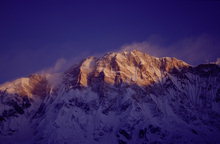 Eventually, the next morning was the same, so there was another cards day.
But the third morning was spectacular! Annapurna main peak seemed so
unbeliavably close.
But we knew we didn't have much time to admire the view. During the storm,
it had been obviously snowing all the time, so there was a lot of fresh
snow and thus greater avalanche danger down in the valley. So we started
descending in deep snow. Our feet were wet in the first 5 minutes, but the
sun was shining and it wasn't too cold. I went down to Bamboo (2300m).
While I was in the valley, there were 3 avalanches: I saw one behind me,
a tiny one before me, and near Doban the Kiwi girls told me about the third.
Eventually, the next morning was the same, so there was another cards day.
But the third morning was spectacular! Annapurna main peak seemed so
unbeliavably close.
But we knew we didn't have much time to admire the view. During the storm,
it had been obviously snowing all the time, so there was a lot of fresh
snow and thus greater avalanche danger down in the valley. So we started
descending in deep snow. Our feet were wet in the first 5 minutes, but the
sun was shining and it wasn't too cold. I went down to Bamboo (2300m).
While I was in the valley, there were 3 avalanches: I saw one behind me,
a tiny one before me, and near Doban the Kiwi girls told me about the third.
 My trek to Annapurna Sanctuary was made much more interesting by the
exceptionally bad weather. They say in March there is usually no snow
in the Sanctuary. Even the ACAP checkpoint people in Birethanti assured me
that everything was fine. I wasn't more than half an hour out of Birethanti
when I met the first disappointed trekker coming back. He said there
were avalanches all over the place, and claimed it was impossible to go
to Sanctuary.
My trek to Annapurna Sanctuary was made much more interesting by the
exceptionally bad weather. They say in March there is usually no snow
in the Sanctuary. Even the ACAP checkpoint people in Birethanti assured me
that everything was fine. I wasn't more than half an hour out of Birethanti
when I met the first disappointed trekker coming back. He said there
were avalanches all over the place, and claimed it was impossible to go
to Sanctuary.






















